Are all text analytics solutions created equal? The short answer is emphatically, “No.” The long answer is that each text analytics platform has a specific offering and an ideal client for their technology. In this article, we’ll examine six top text analytics platforms. We’ll illuminate their strengths and weaknesses and clarify the perfect customer for each.
According to Markets and Markets, the text analysis industry will be worth $22 billion by 2022. Meanwhile, PAT Research list more than 63 vendors in their most recent text analytics software rankings (we’re #4, by-the-by). Clearly, the text analysis market is well-established. But with so many options to choose from, how can you know which text analytics tool is right for your 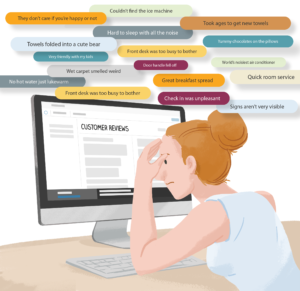 organization? This article aims to help you decide.
organization? This article aims to help you decide.
Here are the top six text analytics vendors to be aware of:
To evaluate each vendor’s offerings, we’ll examine their visualization tools and core natural language processing (NLP) engines. We’ll also look at some customer insights and compare those insights with corporate messaging. Ultimately, no one product fits for every text data-related problem. But as you read this article, you’ll come to know the most reliable vendors in our industry and how each differs in unique selling points.
IBM Watson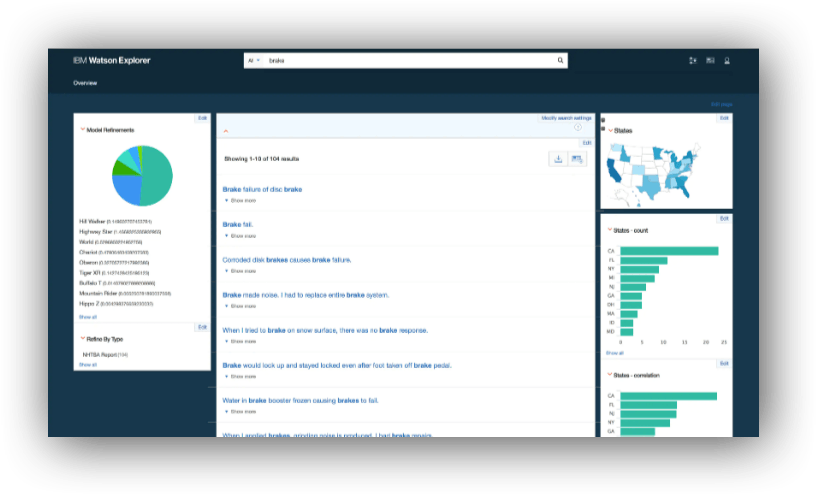
“Do they offer a visualization tool? Yes.”
“Do you have access to the core engine? Yes.”
IBM is a tech behemoth with a long legacy, and IBM Watson is one of the largest artificial intelligence companies in the world. IBM offers a wide range of products, including a tone-analyzer and natural language classifier. Still, their two main offerings are the core-engine, Watson Explorer, and their visualization tool, Watson Studio. Let’s explore these two main offerings.
Watson Explorer
Watson Explorer is a “cognitive exploration and content analysis platform.” IBM’s customers use Watson Explorer to analyze both structured and unstructured text data in order to drive insights for business. Originally, Explorer was IBM’s stand alone core engine and could be deployed to both the cloud or on-premise. Now, with their Deep Analytics Edition, they’re moving toward a fully cloud-based system. They’ve also incorporated a basic-visualization tool, called Content Mining.
Looking at their Gartner Peer Insight reviews we see many clients laud Watson Explorer for its setup. Says one client: “The Watson explorer application is quite simple to configure, and the search engine can be scaled to our view with Watson. Application is pretty easy to install and use with good capabilities.”
After its initial setup the product offers several text analytics capabilities and configurations for analysis. Its command-line document classifiers and model tuning are suited for a traditional data scientist rather than your average professional or data enthusiast. As a self-described “enterprise-ready solution its scaling is robust, but as one reviewer suggests, maybe too much for smaller organizations.
“You have to know about the program before you start using it and be a big company to make it worth investing in.”
Watson Studio
While Explorer offers some visualization tools along with its core analysis engines, IBM provides the bulk of its text visualization under its Watson Studio product line. The platform offers several visualizations to see trends within your data and draw insight. The platforms integrate with many data science tools, which is perfect for data science teams looking for detailed analysis and specific data sources.
Much like their Watson Studio, Explorer’s machine learning development is built by the user from the ground up. Their AutoAI add-on can streamline the process, but it still requires the user to have significant machine learning experience. Watson offers both a cloud and desktop option, but, just like with Explorer, these tools require a sophisticated client to be of value. Gartner Peer Insight reviews highlight the value dilemma of Watson Studio.
“It can provide a lot of value, but the overwhelming part can make it hard for people to want to give it a chance.”
Overall, IBM Watson offers one of the more technically robust solutions on the market, and its ideal audience reflects that. Their platforms are enterprise-level solutions that require a team of data scientists to take advantage of its features. If you’re a smaller enterprise or don’t have much data, Watson may not be the solution for you.
RapidMiner
“Do they offer a visualization tool? Yes.”
“Do you have access to the core engine? Yes.”
RapidMiner markets itself as a machine learning company for enterprise-level clients looking to “drive revenue, reduce costs, and avoid risks.” With a focus on data science teams, their platforms offer customization and specialization equivalent to the IBM Watson suite, but with a scope well beyond text analytics.
RapidMiner’s platform consists of two main elements: the core engine RapidMiner Server and the visualization suite, RapidMiner Studio.
RapidMiner Server
“In general, I am very happy with the application in itself; the company provides upgrades and new features on a regular basis to keep the product relevant and future proof. On the downside the learning curve can be relatively high for the target audience they aim for, and though a lot of improvements has been done on training and examples, there is still room for further improvement. Also, the server environment is not the area where most resources are spend on.“
The RapidMiner Server allows you to create predictive machine learning models and then test them with your datasets or send them directly to RapidMiner Studio. While their offerings are robust, the platform is compartmentalized into several piecemeal products. Applications like Real-Time Scoring and Radhoops analytics are separate and can make the offering complex. The core engine itself is available on-premise or in the cloud, but without their AutoModel web add-on everything must run via the command line.
Several reviews point out that Server can be reliable for an ideal client, but you have to be ready for all that comes with it.
RapidMiner Studio
RapidMiner’s Studio platform offers many statistical tools, especially for those not looking for text analytics specifically. If you primarily need robust text analytics and visualization, then RapidMiner may not be the ideal fit.
“The visualization and (its configuration) part is very poor, The graphics look very outdated. It can be quite slow sometimes, especially when it comes to big and complex data mining models. I personally miss the data exploration functionality of the tool as well.“
The lack of sentiment analysis is faithful to RapidMiner’s financial focus but doesn’t help any organization who’s looking for a text analytics vendor. The RapidMiner Marketplace offers some flexibility for third party add-ons. But, as some reviewers suggest, without RapidMiner’s TurboPrep and AutoModel add-ons, the platform can be challenging.
Microsoft Azure Text Analytics API
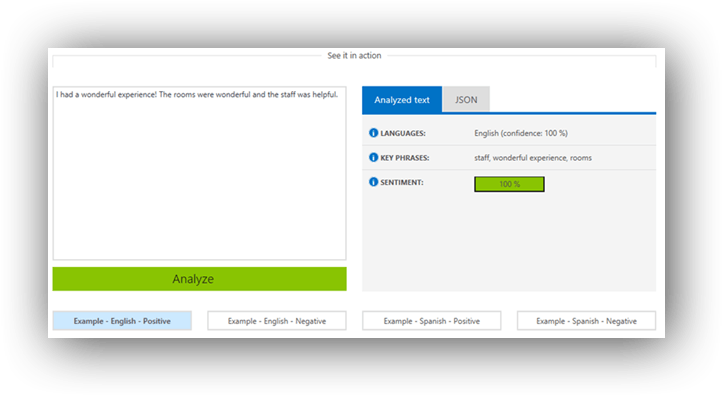
“Do they offer a visualization tool? No.”
“Do you have access to core engine? No.”
Microsoft’s text analytics platform is one of the lowest cost solutions on the market. But that savings comes at a price: the platform offers little to no support and is geared to NLP or data science professionals.
Microsoft Text Analytics API is a self-service text analytics tool. Their pay-as-you-go model allows data scientists the opportunity to process basic text datasets. The cloud-based tool offers sentiment analysis, key phrase extraction, language detection, and entity recognition. However, these functions are not customizable because Microsoft does not provide access to the underlying engine. Reviews highlight its abilities to handle text processing but also cite the basic scope of their projects.
“Great API to process raw text. Makes it easy to see what people think of your product. We use it to collect key phrases in the text input so help analyze what people are saying about the latest product releases.“
Since Microsoft doesn’t offer any visualization tools, the API functions more like a text processing tool rather than a text analytics platform. Another constraint is its 1000 character limit, so it probably won’t work for long-form data or business intelligence problems.
“This program can be of great use for text only analytics and speech to text corrections which are non-technical.”
In the same vein as Clarabridge, this is a small-scale, specific use-case tool rather than a full featured text-analytics solution.
MonkeyLearn
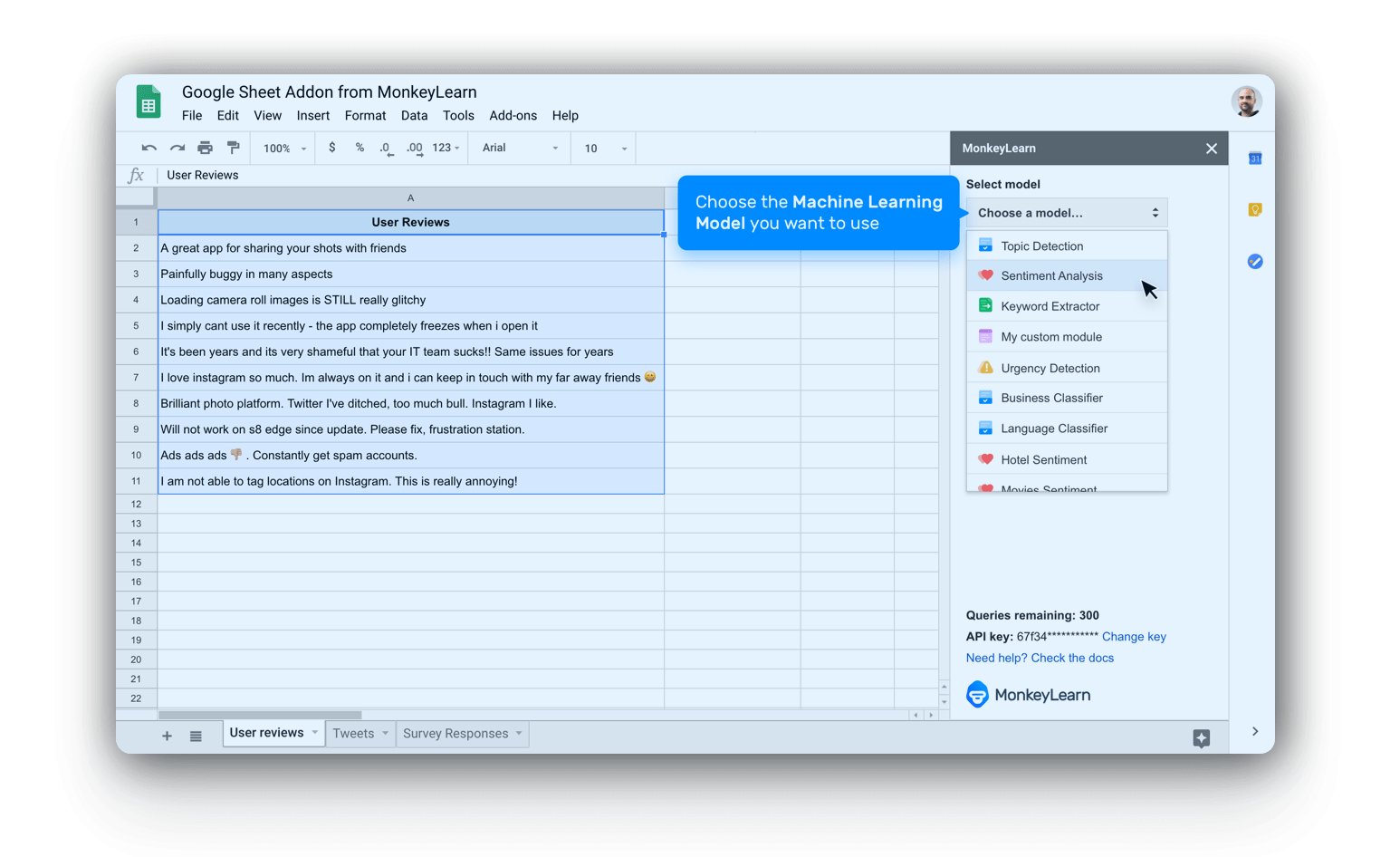
“Do they offer a visualization tool? No.“
“Do you have access to the core engine? No.“
MonkeyLearn is a text analytics company that offers coding-free text classification, extraction services and custom sentiment models. Geared more toward small and mid-size organizations, MonkeyLearn provides many third party integrations. It excels in that it’s well suited to various workflows. Unlike some of the other vendors here, MonkeyLearn does not offer a visualization tool, meaning that what you see is what you get. The free-trial provides a quick look into the platform and gives potential users a taste of the product. Their cloud-based offering is well suited to clients who have little to no machine learning experience. This non-technical user base is supported by a rich library of indexed resources, guides, and API references.
“This software is super easy to use and makes ML algorithms honestly a total piece of cake to create – I’m not even sure how to code.”
To this end, it’s safe to say that MonkeyLearn’s offering is a great fit for business users who have narrow and specific text analytics goals. An issue for some might be MonkeyLearn’s three model and 10,000 queries per month limit. This cap could impede clients who need to handle analysis work at scale. If you’re an organization that requires sophisticated model tuning as a part of a more extensive text analytics solution, then MonkeyLearn is not the right fit. Otherwise, MonkeyLearn is a sleek and straightforward answer to many text-based analysis problems.
Lexalytics
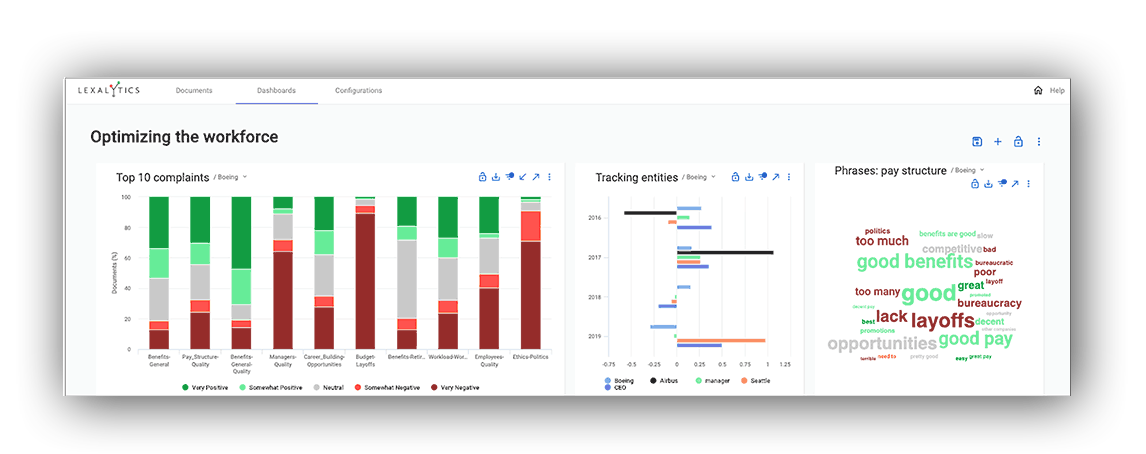
“Do we offer a visualization tool? Yes.”
“Do we have access to the core engine? Yes.”
Bias noted: we at Lexalytics believe in our unique abilities to provide a complete text analytics platform. We are not a customer experience tool like Clarabridge or a no-fuss text processing app like Microsoft Text Analytics. We are a comprehensive text analytics platform. Lexalytics is a three-tiered system designed to provide targeted and valuable technology for your text-based business problems. Below we’ll cover all three of those elements and layout our capabilities and ideal customer.
Our platform consists of our core, on-premise NLP engine, Salience, our cloud NLP technology, Semantria, and our visualization suite, Spotlight, plus our machine learning tool AI Assembler. Combine these powerful elements with our expertise in the Semi-Custom Application business, and we can tackle almost any text-based business problems.
Salience
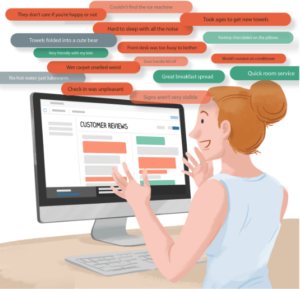
The foundation of our text analytics is our Salience NLP engine. Salience can process over 200 tweets per second while scaling from single process cores to entire data centers. We offer some of the most robust integration options, including Java, PHP, Python, and .NET/C# bindings. Our engine gives clients full access to tune every text analytics and NLP feature. From tokenization and part of speech tagging to sentiment scoring, categorization, and theme analysis.
Using a proprietary pipeline model of NLP and machine learning models, our engine allows our clients to adjust features without disrupting the larger system. If regulations, security, or privacy standards are an organizational concern then our on-premise platform offers complete compliance. On the machine learning front, you can train and deploy custom models through our world-class machine learning team and AI Assembler. Plus, our team of NLP experts are here for you from on-boarding through integration and beyond. We offer direct access to skilled professionals and pride ourselves in both our platform and our ability to solve your text applications.
“The support from the team at Lexalytics was outstanding; they made a very complex project seem simple. With their partnership, we met our goals on time, delivered the best possible product, and were set up to ensure continued success.” — Matt Zarem, Senior Director of Product
Semantria API
If your organization needs a cloud API to solve your text analytics issues, that’s where Semantria comes in. We stake our reputation on our customizations and robust approach to text analytics, and our Semantria API reflects that. Semantria has more features than any other cloud API — and they’re all customizable. Our Categorization and Named Entity Extraction tools are easily trained to match industry-specific vocabulary, and every aspect of our Sentiment Analysis system can be tweaked to match your specifications. We even have a powerful web-based NLP configuration tool wrapped in a graphical user interface (see: Semantria Storage & Visualization below).
“Semantria Software is a good software to analyse the sentiments of the sentences/text/phrases and categorize them into categories defined by the end user with the help of its query building module. It helps us to categorize many sentences easily and user can see the results of defined categories by a plugin in excel or through API interface. It is a user friendly software, easier to understand and very useful in affordable cost.“
We are here to tailor the Semantria API to your needs. And, to back this up, we offer three days of customized professional services free of charge for new licenses.
Spotlight
Our storage and visualization suite, Spotlight, allows organizations to understand customers, employees, and markets better. Once you connect your structured and unstructured data into a single platform, you can process and run insightful analyses. Our default configurations already offer out-of-the-box accuracy and quick insights. And our pre-built industry packs (along with our straightforward tuning platform) allows clients to hone the precision and recall of any analysis, no matter the industry or use case.
Want to see it in action? Check out how we used Spotlight in a Voice of Employee guide for Boeing and Voice of Customer analysis for Best Western.
Spotlight extracts the most data points of any text analytics provider, including topics, categories, themes, named entities, summaries, and intentions. Then we assign multi-layered sentiment scores so you can see what people are talking about, how they feel, and why they feel that way. The final piece to this puzzle is our analytics dashboards, where clients use dynamic visualizations to reveal and share trends and patterns within their text data.
“Lexalytics is the only vendor we’ve seen that can offer the right combination of power, flexibility, and reliability we need to support our complex product line.” – Csaba Dancshazy, Senior Manager, Microsoft Marketing
By combining our Salience, Semantria, and Spotlight tools into a modular NLP platform, we’re able to help organizations across a broad range of verticals solve a wide variety of text data-related business problems.
Interested in hearing more? Get in touch with us today and schedule a platform demo using your own data!